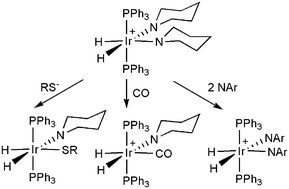Synthesis and reactivity of iridium complexes with pyridine and piperidine ligands: models for hydrodenitrogenation†
Abstract
The complexes [Ir(H)2(η1-N-L)2(PPh3)2]PF6, L = py (1), iQ (2) and pip (3) (py = pyridine, iQ = isoquinoline, pip = piperidine) have been synthesized in high yields by hydrogenation of [Ir(cod)(PPh3)2]PF6 in the presence of the appropriate nitrogen compound. When hydrogen is bubbled through 1,2-dichloroethane solutions of 1 or 2, two new species were formed in each case by C–Cl bond activation of the solvent, Ir(H)2Cl(η1-N-L)(PPh3)2 (L = py, 4; iQ, 5) and IrH(Cl)2(η1-N-L)(PPh3)2 (L = py, 6; iQ, 7). Reaction of 3 with py or iQ yielded complexes 1 and 2, respectively, while under a slow stream of carbon monoxide the complex [Ir(H)2(η1-N-pip)(CO)(PPh3)2]PF6 (8) was produced. Complex 3 also reacts with halide and 4-bromothiophenolate anions leading to the corresponding neutral species Ir(H)2(X)(η1-N-pip)(PPh3)2, X = Cl (9), I (10) and 4-BrC6H4S (11), or with [MoS4]2− to yield the hetero-bimetallic complex [Ir(H)(PPh3)2(μ-S)2MoS2]− (13). All the new complexes were characterized by analytical and spectroscopic methods. The X-ray structures of 1, 2 and 8 consist of distorted octahedra with a mutually cis disposition of the two hydrides and mutually trans phosphines. Complexes 1, 2 and 3 and their derivatives are of interest as models for the chemisorption step in hydrodenitrogenation reactions on solid catalysts.


 Please wait while we load your content...
Please wait while we load your content...